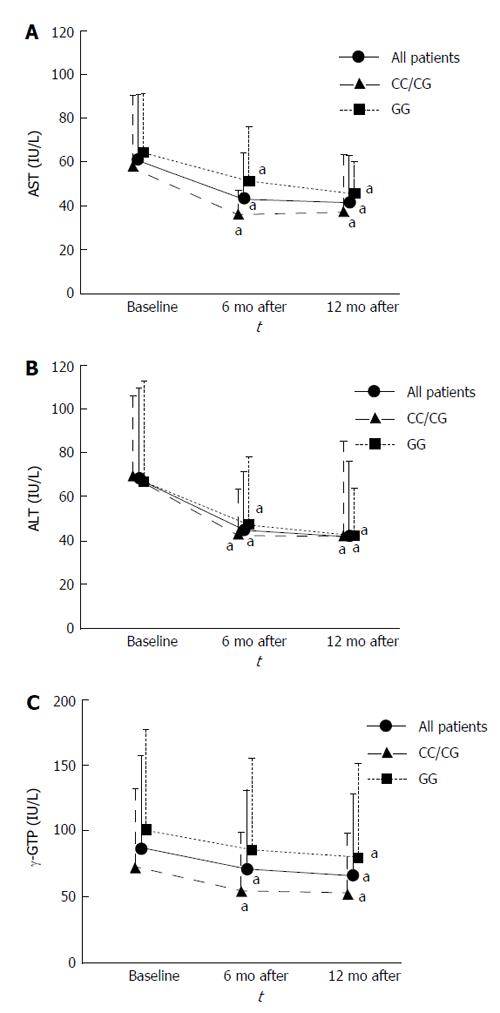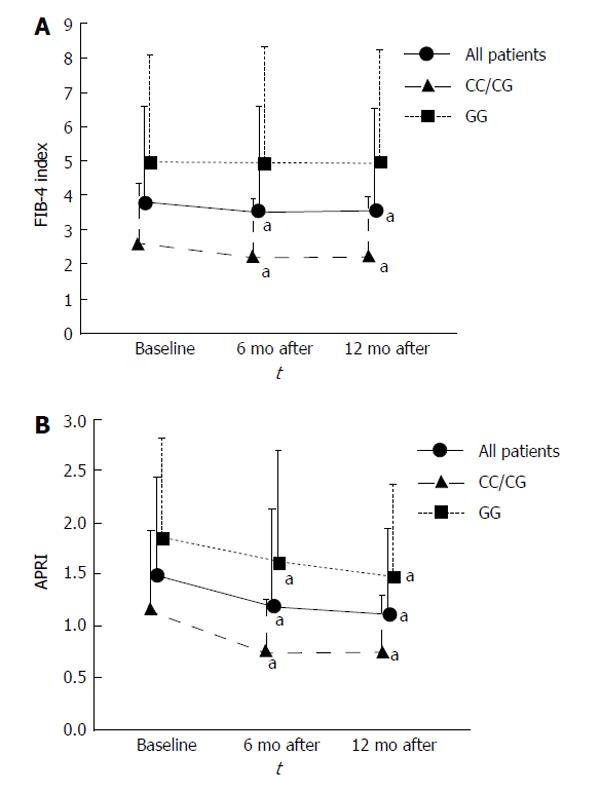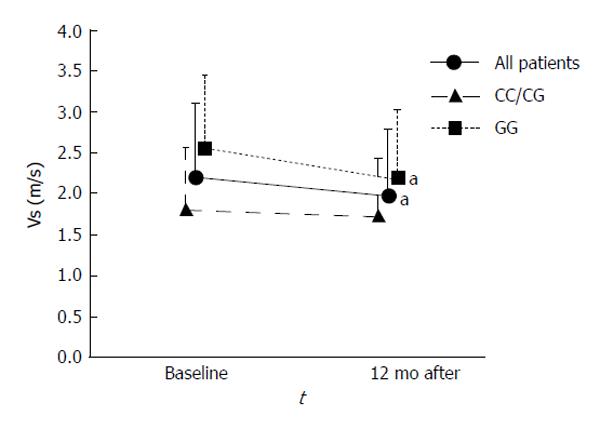Copyright
©The Author(s) 2015.
World J Hepatol. Nov 28, 2015; 7(27): 2749-2756
Published online Nov 28, 2015. doi: 10.4254/wjh.v7.i27.2749
Published online Nov 28, 2015. doi: 10.4254/wjh.v7.i27.2749
Figure 1 Characteristics of patients included in this study.
The study comprised 38 patients with nonalcoholic fatty liver disease (NAFLD) who were administered vitamin E for > 1 year. The patients were genotyped SNP rs738409 and divided into two groups by genotype (CC/CG and GG) to examine the difference in the response to vitamin E.
Figure 2 Effects of vitamin E treatment on liver enzyme levels.
aIndicate a difference when the results are compared with baseline values (P < 0.05). A: Evolution of AST during the study period. Serum AST levels in all patients decreased from baseline to 6 and 12 mo (P < 0.001 and P < 0.001, respectively). Serum AST levels in the CC/CG group decreased from baseline to 6 and 12 mo (P = 0.004 and P < 0.001, respectively). Serum AST levels in the GG group also decreased from baseline to 6 and 12 mo (P = 0.045 and P = 0.011, respectively); B: Evolution of ALT during the study period. Serum ALT levels in all patients decreased from baseline to 6 and 12 mo (P < 0.001 and P < 0.001, respectively). Serum ALT levels in the CC/CG group decreased from baseline to 6 and 12 mo (P = 0.022 and P < 0.001, respectively). Serum ALT levels in the GG group also decreased from baseline to 6 and 12 mo (P = 0.004 and P < 0.001, respectively); C: Evolution of γ-GTP during the study period. Serum γ-GTP levels in all patients decreased from baseline to 6 and 12 mo (P = 0.019 and P < 0.001, respectively). Serum γ-GTP levels in the CC/CG group decreased from baseline to 6 and 12 mo (P = 0.047 and P = 0.003, respectively). Those in the GG group decreased from baseline to 12 mo (P = 0.005). AST: Aspartate aminotransferase; ALT: Alanine aminotranferease; γ-GTP: γ-glutamyl transpeptidase.
Figure 3 Effects of vitamin E treatment on results of noninvasive scoring systems of hepatic fibrosis.
aIndicate a difference compared with baseline values (P < 0.05). A: Evolution of FIB-4 index during the study period. FIB-4 index in all patients decreased from baseline to 6 and 12 mo (P = 0.015 and P = 0.035, respectively). The FIB-4 index in the CC/CG group also decreased from baseline to 6 and 12 mo (P = 0.014 and P = 0.017, respectively); B: Evolution of APRI during the study period. APRI in all patients decreased from baseline to 6 and 12 mo (P < 0.001 and P < 0.001, respectively). APRI in the CC/CG group decreased from baseline to 6 and 12 mo (P = 0.004 and P < 0.001, respectively). APRI in the GG group also decreased from baseline to 6 and 12 mo (P = 0.028 and P = 0.036, respectively). FIB-4: Fibrosis-4; APRI: Aminotransferase-to-platelet index.
Figure 4 Evolution of velocity of shear wave during the study period.
aIndicate a difference compared with baseline values (P < 0.05). Velocity of shear wave (Vs) in all patients decreased from baseline to 12 mo (P = 0.005). Vs in the GG group also decreased from baseline to 12 mo (P = 0.029), and that in the CC/CG group also tended to decrease (P = 0.083).
- Citation: Fukui A, Kawabe N, Hashimoto S, Murao M, Nakano T, Shimazaki H, Kan T, Nakaoka K, Ohki M, Takagawa Y, Takamura T, Kamei H, Yoshioka K. Vitamin E reduces liver stiffness in nonalcoholic fatty liver disease. World J Hepatol 2015; 7(27): 2749-2756
- URL: https://www.wjgnet.com/1948-5182/full/v7/i27/2749.htm
- DOI: https://dx.doi.org/10.4254/wjh.v7.i27.2749












